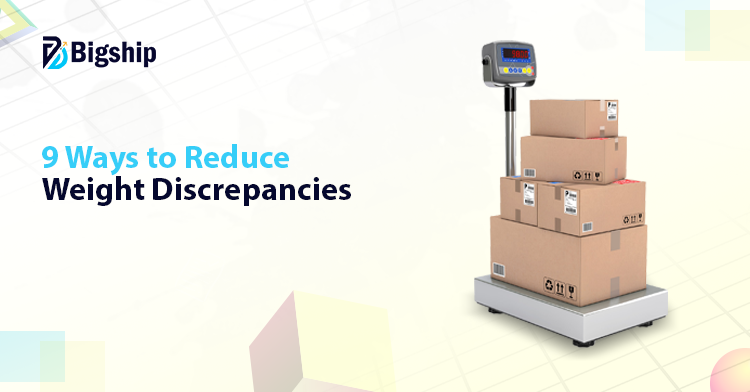Weight discrepancies can prove to be serious challenges for businesses, big or small. Depending on whether the shipment weighs more or less than the declared weight, there can be additional charges, shipment delays, and tension among courier partners or customers.
Apart from shipment costs, they can close the entire supply chain from working. Hence, it becomes of utmost importance to save such discrepancies with due measures.

In this blog, we’ll understand the concept of weight discrepancies, the effect they have on your business, and 9 proven ways to reduce them so that your logistics keep running smoothly.
What is weight discrepancy?
Weight discrepancy cases are usually lodged when the weight stated at the time of shipment booking does not match what the courier weighs. Although being a minor mismatch, this can trigger significant disruptions, impacting cost, delivery timelines, and customer satisfaction.
Ensuring the accurate weight of the package is measured to minimize the weight discrepancies and avoid unexpected issues. Addressing the weight discrepancy with the trusted system and procedure weight discrepancy solutions is crucial for businesses to maintain efficiency, reduce costs, and build trust with their partners & customers.
Common Reasons for Weight Discrepancies
1. Inaccurate Weighing Scales: Occasionally, outdated or poorly maintained weighing equipment is used; hence, readings can be inaccurate. Even slight calibration drifts can cause major mismatches over time.
2. Ignoring the Volumetric Weight: Most shippers only consider the physical weight for their calculation and do not realize that in most cases, couriers will charge for the larger weight of the two.
3. Over or Improper-Packing: Inadequate packaging, which might involve excessively bulky packing material or unnecessary fillers, could lead to an increase in the parcel weight.
4. Discrepancies in Courier Reweighing: Couriers may occasionally reweigh shipments from small locations, such as warehouses and hubs, where there are more mistakes in recording updated weights.
5. Lack of Staff Awareness: Problems often arise when staff members aren’t properly trained in weighing techniques, packaging standards, or courier policies.
6. Changes During Transit: External factors such as moisture absorption, temperature changes, or tampering can alter package weight.
7. False Declaration of Weight: Either intentionally or accidentally declaring a lesser weight has fostered penalties and billing contests.
8. Incorrect Documentation: A mismatch between system weight data entry and actual parcel weights could arise when shipment creation or label generation involves a manual entry mistake on weight data.
9. Multiple Points of Handover: Shipments have to go through several courier hubs or handling stages are prone to being reweighed, thus giving rise to manual interventions.
Impacts of Weight Discrepancies
1. Financial Loss: Carriers may impose additional costs or fines for the incorrect entry of weight. The company might dispute costs with the customer due to increased shipping costs.
2. Delivery Delays: Typically, shipments are held for inspection if they correspond with the allegedly mismatching weight, which obstructs shipments and delays delivery timelines.
3. Brand Credibility Damage: Ongoing weight-related conflicts can affect relationship-building with courier partners and build trust issues with customers. If deliveries take too long or cost more than promised, customers may leave negative reviews.
4. Operational Inefficiency: Resources are wasted in resolving disputes, reweighing packages, and managing courier relations.
5. Reduced Profit Margins: Hidden costs and recharges from wrong declarations might mislead cost calculations and slowly result in eating into margins.
Top 9 Ways to Reduce Weight Discrepancies
Here are some of the sure-shot ways to get away with weight discrepancies.
1. Invest in High-Quality Weighing Scales
Invest in your facility with the most reliable digital weighing scales first. High-precision scales will compensate for weight differences due to updated and poorly maintained equipment. Scales must be regularly calibrated in order to maintain accuracy over time and prevent inadvertent billing.
2. Consider Dimensional Weight
Knowing the dimension weight is just as important as knowing the actual weight. The shipping companies work on dimensional weight to price a parcel, as they realize that a large or bulky freight requires space to be moved through, even if it might be feather-light in mass.
A business should never be hit with an unexpected freight charge, so when packages are prepared for sale, the length, width, and height are all measured and used to calculate the appropriate dimensional factor (L × W × H ÷ 5000). Among the two weights, the higher is given preference as the chargeable weight.
Through correct calculation and declaration, businesses remain on good terms with couriers and avoid reweighing disputes or added charges.
3. Packaging Efficiency
Improving the packaging technique can avoid unnecessary weight. From a weight point of view, you may go for very lightweight materials in corrugated boxes or air pillows rather than heavyweight fillers. Avoid large boxes, tape, or inserts, as these also count for the final weighing. Packaging that fits in properly also reduces volume-weight charges.
4. Integrate Automated Weighing and Dimensioning Systems
Manual errors are highly reduced by automation. Weighing machines and dimensioning sensors work together to capture package weight and size in a single step. This process is highly beneficial for operations with weight and speed advantages and where accuracy and consistency are equally important.
5. Training Staff on Shipping Protocols
Staff training is crucial to reduce issues related to weighing. The personnel must know the correct method of weighing, packaging, and shipment details. Ongoing training ensures that the crew continues to be aware of courier requirements, along with the cost implications of improper entries on weight.
6. Cross-Verification of Weights Using Courier APIs
Courier integrations can ensure that the declared weight is true at the time of booking. Many of them will provide APIs or other means of ensuring that what you input matches the standard they accept. Weight validation in the early stages will catch discrepancies before shipments leave, causing risk of penalties, returns, or disputes in billing.
7. Smarter Shipping with Aggregator Platforms
Shipping platforms, like Bigship, empowered with technology, take the process to another level. These aggregators interface with multiple courier systems, enable real-time weight verification, and transparent rate calculations. They also offer shipment tracking, RTO data, and audit logs, helping businesses detect recurring weight discrepancies.
8. Use More Tech Tools for Complete Control and Visibility
Visibility in shipping is extremely important. The warehouse management system (WMS) or courier dashboard tools, among others, provide weight and dimension data in real-time directly from the devices integrated with them. This sort of automation eliminates, or at least minimizes, manual errors entered into the system.
9. Be Transparent about Relationships with Your Courier Partners
Regular communication with your shipping partners will help mitigate many obstacles. You can protect yourself by requesting extensive shipment reports, internalizing weight dispute policies, and understanding their margin of error. Collaborating with your courier partner will not only empower you to actively resolve disputes but will also open the door to process improvements and more favorable terms over time.
Conclusion
At Bigship, we know that weight discrepancies aren’t just small errors, they can lead to big headaches. From unexpected charges to courier disputes and delays, these issues can seriously affect your business operations and reputation.
That’s why Bigship is built to help you stay ahead. With smart tech integrations, real-time syncing with courier systems, and tools to validate both actual and dimensional weight, we make sure your shipments are accurate from the start. By eliminating guesswork and reducing manual errors, Bigship helps you cut costs, ship smarter, and focus on growth, not on fixing shipment issues.
Sign up with Bigship to manage smarter, faster, and more accurate shipping all in one place.





